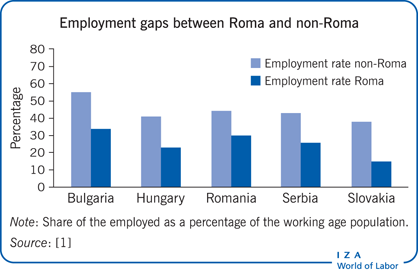Elevator pitch
The Roma are the largest ethnic minority in Europe—as well as one of the most disadvantaged. A triple vicious circle is at play: Substandard socio-economic outcomes reinforce each other; they fuel negative attitudes and perceptions, leading to ill-chosen policies; and segmentation is perpetuated through (statistical) discrimination. A severe lack of data precludes progress. However, existing bits of evidence point to virtuous ways out.
Key findings
Pros
A severe segmentation of Roma and non-Roma populations is documented in both human capital and labor market outcomes.
Residential segregation results in gaps in educational attainment, which is a key factor behind these labor market disparities.
Socio-economic gaps are perpetuated through the link between parents’ education and household resources and the educational achievement of children.
Awareness of the severity of the Roma’s situation, of the lack of reliable data, and of the inadequacy of integration policies is increasing.
There are policy options that can facilitate the social and economic integration of Roma.
Cons
The lack of data and multiple measurement biases make measuring Roma populations and their socio-economic conditions almost impossible.
Roma are a highly heterogeneous population in their level of integration and labor market position, making generalizations problematic.
Closing the human capital gap between Roma and non-Roma may not be sufficient to provide equal chances in the labor market, as differentials in returns to human capital, signalling unequal treatment, appear to be the norm.
Political elites lack the will and courage to address Roma integration challenges.
